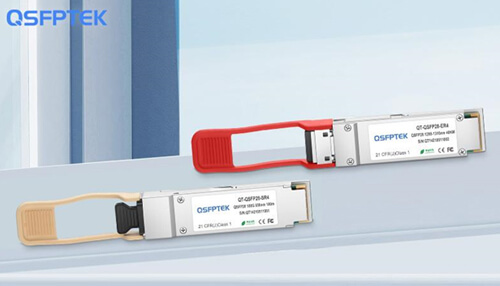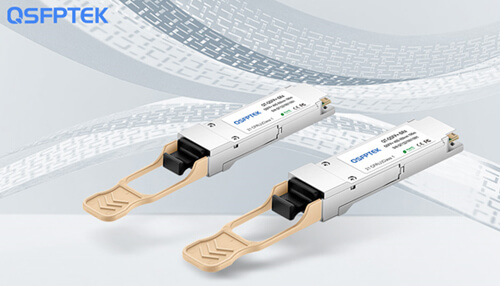This article will introduce the working principle of the QSFP 40G Optical Transceiver, specifically the 40GBASE-SR module. The 40GBASE-SR4 module is generally used for short-distance optical signal transmission. It uses the MLD (Multiple-Lanes Distribution) mechanisms inside. In this article, we will introduce the internal transmission principle of 40GBASE-SR4 in detail.
40G Optical Transceiver Wiki
The main form factor of the 40G optical module is QSFP+, and the QSFP+ factor is an optical module package type specially defined by the IEEE organization for 40G Ethernet network, in line with SCSI, 40G Ethernet, 20G/40G Infiniband and other standards. The number of data channels of 40GBASE-SR4 is 4×10 Gbps. The transmission rate of 40G QSFP+ SR4 optical modules can reach 40Gbps at the same time. QSFP+ optical module has two interfaces: LC and MTP/MPO, which are used for single-mode applications and multi-mode applications respectively. The 40GBASE-SR4 is equipped with an MTP connector.
Introduction of MLD (Multi-Lanes Distribution)
Compared with the 10G Ethernet, the most critical improvement in the 40G QSFP+ SR4 optical modules is the design of the MLD multi-lane distribution mechanism. The mechanism of MLD in 40GBASE-SR4 is to perform 64B/66B encoding on the serial data stream of the MAC layer at the PCS layer, then “cut” it into several code blocks, and then use the round-robin scheduling algorithm to distribute the code blocks to multiple code blocks in turn. In the virtual channel, the data enters the PMA and PMD layers in the optical module and then is converted and transmitted and the “serial” data is temporarily converted into “parallel” data. Double the speed and reduce the system clock frequency requirements.
The original 10G Ethernet can be extended to 40G Ethernet by using the MLD mechanism. According to the specification of the optical transmission protocol, in the PCS sublayer, it is necessary to establish a number of L virtual channels (40G is 4, 100G is 20) to split the data packets and send them. Add headers to each channel for easy recovery. A virtual channel is a logical channel on the PCS layer, and the number of channels is related to the number M of interface channels between the electrical layer slices in the PMA layer, and the number N of channels connected to the optical fiber medium at the PMD layer.
40G Optical Transceiver Transmission Sequence
- The PCS sublayer uses 64B/66B encoding to encode the serial data stream into a continuous stream of code blocks and scrambles it.
- A round-robin scheduling algorithm is used to send the scrambled data to L virtual channels respectively. When polling, each channel must add a special flag bit for the recording sequence, which is convenient for data recovery later.
- The PMA layer forms the XLAUI or CAUI interface channel data of the M channels through the bit-wise multiplexing method of the L virtual channel data.
- The data is connected to the PMA layer corresponding to the optical module device through the XLA UI or CAUI interface, and the M-channel XL AUI or CAUI interface data is converted into N-channel channel data and connected to the PMD layer.
Conclusion
Through this article, I believe you already have an understanding of the structure of QSFP+ optical modules. 40GBASE-SR4 is generally used with OM3 or OM4 MMF to build high-density 40G Ethernet. If you want to know more about 40GBASE-SR4, you can contact QSFPTEK customer service via sales @qsfptek.com, QSFPTEK is a company specializing in the production of optical components including 40GBASE-SR4, 10GBASE-T, and a series of optical modules and related products.



